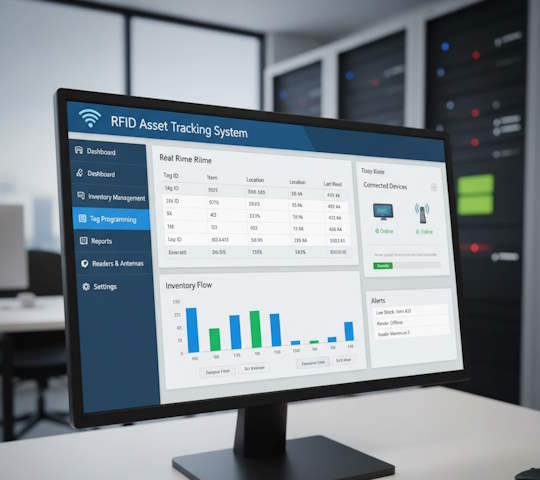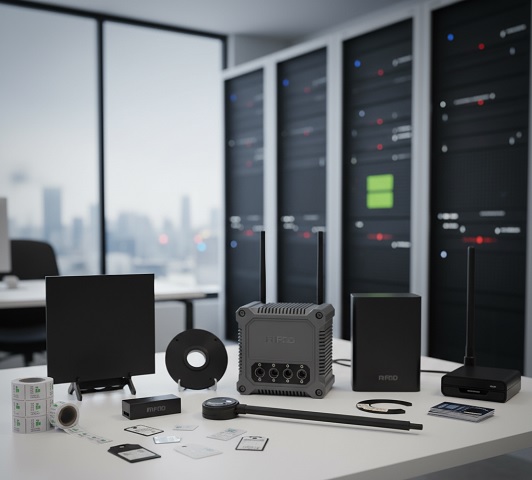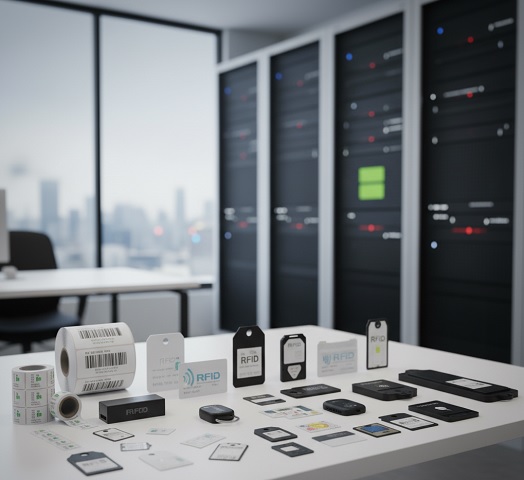RFID Implementation for Vehicle Tracking and Management in Grain Elevators and Storage Facilities
Executive Summary
In the global agricultural supply chain, operational efficiency determines competitive advantage. Grain elevators and storage facilities, as critical infrastructure nodes in the commodity supply chain, face mounting pressure to minimize losses while maximizing throughput capacity. Radio Frequency Identification (RFID) technology has emerged as the industry standard for automated vehicle tracking, enabling real-time visibility of every unit in the fleet while establishing the foundation for comprehensive digital transformation of logistics operations.
With global grain trade volumes exceeding 400 million metric tons annually¹, even marginal efficiency improvements translate into substantial competitive advantages and cost savings across the supply chain.
The Business Case for Automation in Modern Grain Logistics
Legacy tracking systems based on manual documentation and data entry create significant operational vulnerabilities. According to McKinsey Global Institute's "Digital Agriculture: Mapping the Future" report¹, potential losses from human error, manipulation, and operational delays in agricultural logistics range from 3-7% of total throughput value.
Critical operational challenges include:
Human Error Impact: Inaccuracies in vehicle identification, weight recording, and operational timestamps leading to inventory discrepancies and compliance issues.
Throughput Bottlenecks: Queue formation at control points during peak harvest seasons, directly impacting facility capacity utilization and customer service levels.
Analytics Blind Spots: Inability to conduct precise operational time studies, preventing identification of process bottlenecks and optimization opportunities.
Compliance and Security Risks: Potential for unauthorized activities during weighing and sampling operations, particularly critical for export-grade commodities requiring strict chain of custody documentation.
RFID Technology Framework and Global Standards
Modern RFID implementations are built on the EPCglobal UHF Class 1 Gen 2 standard, developed by GS1². This protocol, formally ratified as ISO/IEC 18000-63³, defines operational requirements for passive UHF RFID systems (commercially known as RAIN RFID⁴) operating in the 860–960 MHz frequency band.
Current Standard Evolution
Generation 2 Version 2 (ISO/IEC 18000-63:2015): Enhanced security features including improved encryption and authentication protocols.
Generation 2 Version 3: Advanced privacy protection capabilities with cryptographic authentication and secure communication channels.
System Architecture Components
UHF Tags: Passive transponders leveraging reader signal energy for operation. Industrial-grade tags feature IP67-rated enclosures with tamper-evident designs, operating reliably across temperature ranges of -40°C to +85°C.
Reader Infrastructure: Fixed and mobile units from industry leaders including Impinj (Speedway series) and Zebra Technologies (FX series), offering read ranges up to 12 meters and multi-tag simultaneous processing capabilities.
Integration Platform: Enterprise-grade middleware connecting RFID data streams with corporate ERP systems including SAP S/4HANA, Oracle ERP Cloud, and Microsoft Dynamics 365 Supply Chain Management.
Strategic Control Point Implementation
Best-practice deployments establish RFID checkpoints at critical nodes throughout the facility's operational workflow:
1. Main Gate Access Control
Implementation: Fixed readers integrated with automated gate control systems, boom barriers, and traffic management infrastructure.
Business Impact: Automated vehicle identification and timestamp logging eliminate manual check-in processes, reducing gate processing time by 60-80% while providing complete audit trails for security and compliance purposes.
2. Weighbridge Integration
Implementation: Portal-mounted readers positioned at scale approach and departure points, with direct integration into certified weighing systems.
Business Impact: Instantaneous linking of gross/tare weight data to vehicle identifiers eliminates manual data entry errors and provides real-time inventory updates. Critical for maintaining USDA, EU, and international commodity trading standards.
3. Sampling and Loading/Unloading Zones
Implementation: Overhead reader arrays positioned strategically throughout operational areas.
Business Impact: Automated timestamping and location tracking ensure complete commodity traceability, supporting quality assurance programs and regulatory compliance requirements.
Regulatory Compliance Framework
North American Regulations
United States: Federal Communications Commission (FCC) Part 15.247 permits operation in the 902–928 MHz band with maximum Equivalent Isotropically Radiated Power (EIRP) of 4 watts, enabling extended read ranges suitable for large-scale elevator operations.
Canada: Innovation, Science and Economic Development Canada (ISED) RSS-210 provides similar frequency allocations with harmonized power limits, facilitating cross-border operations for integrated supply chains.
European Union Standards
ETSI EN 302 208: Defines operation in the 865–868 MHz band with mandatory "Listen Before Talk" (LBT) functionality and maximum Effective Radiated Power (ERP) of 2 watts. Compliance essential for facilities serving EU export markets.
Asia-Pacific Considerations
China: Ministry of Industry and Information Technology (MIIT) regulations specify 920–925 MHz operations. Japan: Ministry of Internal Affairs and Communications (MIC) permits 952–954 MHz frequency usage. Australia: Australian Communications and Media Authority (ACMA) allows 920–926 MHz operations under LIPD class licensing.
Quantified Business Benefits: Industry Performance Data
Comprehensive analysis by Accenture's "Digital Agriculture Revolution" study⁷, examining 150+ agricultural facilities across North America and Europe, demonstrates measurable ROI from RFID implementation:
Operational Efficiency Gains
- Throughput Increase: 35-45% improvement in vehicle processing speed
- Data Accuracy: 90-98% reduction in manual data entry errors
- Queue Reduction: 65-75% decrease in vehicle waiting times during peak operations
- Labor Optimization: 20-30% reduction in administrative overhead through process automation
Financial Performance Impact
- Cost Reduction: $0.15-0.25 per metric ton processed through operational efficiency gains
- Revenue Protection: Elimination of shrinkage losses typically saving $50,000-150,000 annually for medium-scale facilities
- Compliance Costs: 40-60% reduction in audit preparation time and documentation costs
Case Study: Cargill's North American Implementation
Cargill Incorporated, North America's largest private grain handler, completed a comprehensive RFID deployment across 47 elevator facilities between 2021-2023⁸.
Technical Specification
- Hardware: Impinj Speedway R700 fixed readers with CircPol antennas
- Tag Population: 2,500+ vehicles equipped with Confidex Ironside Micro tags
- Integration: SAP S/4HANA integration via Cargill's proprietary middleware platform
- Coverage: 47 facilities across 12 states processing 15+ million metric tons annually
Performance Outcomes
- Processing Speed: 42% reduction in average truck turnaround time
- Operational Accuracy: 99.7% data accuracy across all measured parameters
- Cost Savings: $12.3 million annual operational cost reduction
- ROI Achievement: 16-month payback period with 23% IRR over 5-year projection
- Customer Satisfaction: 89% improvement in carrier satisfaction scores due to reduced wait times
Scalability Results
The success of the initial deployment led to expansion across Cargill's global network, with implementations planned for South American and European facilities, demonstrating the technology's scalability across diverse regulatory and operational environments.
Investment Analysis and Financial Modeling
Capital Requirements (Medium-Scale Facility: 100,000 MT capacity)
RFID Infrastructure: $45,000 - $65,000
- Fixed readers and antennas: $35,000 - $50,000
- Vehicle tags (500 units): $5,000 - $7,500
- Installation and calibration: $5,000 - $7,500
Software and Integration: $25,000 - $40,000
- Middleware platform licensing: $15,000 - $25,000
- ERP integration development: $10,000 - $15,000
Implementation Services: $15,000 - $25,000
- Project management and training: $8,000 - $12,000
- Change management and documentation: $7,000 - $13,000
Total Investment Range: $85,000 - $130,000
Return on Investment Model
- Payback Period: 14-22 months
- 5-Year NPV: $180,000 - $320,000 (at 8% discount rate)
- Internal Rate of Return: 18-28%
Implementation Best Practices
Phase 1: Assessment and Planning (4-6 weeks)
- Operational workflow analysis and bottleneck identification
- Facility site survey and RF environment assessment
- Integration requirements definition and technical architecture design
Phase 2: System Design and Procurement (6-8 weeks)
- Hardware specification and vendor selection
- Software development and integration planning
- Regulatory compliance verification and certification
Phase 3: Installation and Testing (4-6 weeks)
- Hardware installation and commissioning
- System integration and data flow validation
- User acceptance testing and performance verification
Phase 4: Deployment and Training (2-4 weeks)
- Staff training and change management
- Phased production rollout
- Performance monitoring and optimization
Future Technology Trends
Edge Computing Integration
Advanced implementations incorporate edge computing capabilities, enabling real-time analytics and decision-making at the facility level without dependence on cloud connectivity.
AI-Powered Analytics
Machine learning algorithms analyze historical traffic patterns to predict peak periods and optimize resource allocation, further enhancing operational efficiency.
Blockchain Integration
Emerging implementations integrate blockchain technology for immutable commodity tracking, particularly valuable for organic and specialty grain markets requiring enhanced traceability.
Conclusion
RFID implementation for vehicle tracking represents a strategic investment in operational excellence for grain elevator facilities. Alignment with international GS1 standards and deployment of proven technology platforms ensures reliability and scalability across diverse operational environments.
In an increasingly competitive global commodity market, facilities that leverage automation technologies gain decisive advantages in cost structure, operational reliability, and customer service delivery. The technology has matured beyond early adoption phases, with proven ROI models and extensive vendor ecosystem support making implementation both feasible and financially attractive for facilities of all scales.
The convergence of regulatory requirements, customer expectations, and competitive pressures makes RFID adoption not merely advantageous but essential for maintaining market position in modern grain logistics operations.
Frequently Asked Questions (FAQ)
General Implementation
What is the typical ROI timeline for RFID implementation in grain elevators?
Most facilities achieve ROI within 14-22 months, with larger operations (100,000+ MT capacity) typically seeing faster returns due to higher transaction volumes. The Cargill case study demonstrated a 16-month payback period with 23% IRR over 5 years.
What are the total implementation costs for a medium-scale elevator?
For a 100,000 MT capacity facility, total investment ranges from $85,000 to $130,000, including:
- RFID infrastructure: $45,000-$65,000
- Software and integration: $25,000-$40,000
- Implementation services: $15,000-$25,000
How long does a complete RFID implementation take?
A typical deployment follows a 4-phase approach over 16-24 weeks:
- Phase 1: Assessment and Planning (4-6 weeks)
- Phase 2: System Design and Procurement (6-8 weeks)
- Phase 3: Installation and Testing (4-6 weeks)
- Phase 4: Deployment and Training (2-4 weeks)
Technical Specifications
What read range can I expect from UHF RFID systems?
Fixed readers (Impinj Speedway series) typically achieve 8-12 meter read ranges with proper antenna positioning. Mobile/handheld readers provide 3-6 meter ranges. Actual performance depends on environmental factors, tag orientation, and interference.
Do RFID systems work in harsh grain elevator environments?
Yes, industrial-grade tags with IP67 ratings operate reliably in temperatures from -40°C to +85°C and withstand dust, moisture, and physical impact. However, metal structures and grain dust can affect performance, requiring proper system design.
What's the difference between Gen2v2 and Gen2v3 RFID standards?
- Gen2v2 (ISO/IEC 18000-63:2015): Enhanced security with improved encryption
- Gen2v3: Advanced privacy protection with cryptographic authentication and secure communication channels Both are backward compatible with existing Gen2 infrastructure.
Regulatory and Compliance
What frequency bands are legal for RFID in different regions?
- United States: 902-928 MHz (FCC Part 15.247), max 4W EIRP
- European Union: 865-868 MHz (ETSI EN 302 208), max 2W ERP with LBT
- China: 920-925 MHz (MIIT regulations)
- Japan: 952-954 MHz (MIC permits)
Do I need special licensing for RFID operation?
No special licensing required in most regions. RFID operates in unlicensed ISM bands, but must comply with regional power limits and technical standards. Always verify local regulations before deployment.
How does RFID compliance affect export documentation?
RFID systems enhance compliance by providing:
- Automated chain of custody tracking
- Precise timestamps for all operations
- Immutable audit trails for USDA/EU export requirements
- Reduced documentation errors and compliance costs by 40-60%
Operational Concerns
How many vehicles can be processed simultaneously?
Modern fixed readers can process 200+ tags simultaneously within the read zone. Gate processing time is reduced by 60-80% compared to manual systems, with sub-second identification of vehicles.
What happens if RFID tags are damaged or lost?
- Replacement cost: $2-5 per industrial tag
- Backup systems: Manual override capabilities for emergency situations
- Tag durability: Industrial tags typically last 3-5 years in normal operation
- Lost tag protocols: Deactivation procedures prevent unauthorized use
Can RFID integrate with existing weighbridge systems?
Yes, RFID readers integrate directly with most certified weighing systems through:
- RS-232/485 serial connections
- TCP/IP network interfaces
- Modbus or proprietary protocols Integration eliminates manual data entry and provides real-time inventory updates.
ERP and Software Integration
Which ERP systems are compatible with RFID platforms?
Most enterprise ERP systems integrate via standard APIs:
- SAP S/4HANA: Direct integration through SAP AII
- Oracle ERP Cloud: RESTful API connections
- Microsoft Dynamics 365: Supply Chain Management modules
- Custom systems: XML/JSON data exchange protocols
Can RFID data be accessed remotely?
Yes, modern RFID middleware provides:
- Cloud-based dashboards for real-time monitoring
- Mobile applications for remote access
- API endpoints for third-party integrations
- Automated reporting via email/SMS alerts
How is RFID data backed up and secured?
Data security measures include:
- Encrypted data transmission (AES-256)
- Regular database backups (on-site and cloud)
- User access controls with role-based permissions
- Audit logging for all system interactions
- GDPR/privacy compliance features where applicable
Troubleshooting and Maintenance
What ongoing maintenance is required?
Minimal maintenance needed:
- Reader calibration: Annual or bi-annual
- Antenna cleaning: Quarterly in dusty environments
- Software updates: As released by vendors
- Tag replacement: 3-5 year lifecycle for vehicle tags
How do I troubleshoot read performance issues?
Common solutions:
- Check antenna alignment and positioning
- Verify power levels within regulatory limits
- Assess RF interference from nearby equipment
- Clean antenna surfaces from dust/debris
- Update reader firmware to latest versions
What support is available from vendors?
Vendor support typically includes:
- 24/7 technical hotlines for critical issues
- Remote diagnostic capabilities
- On-site service contracts available
- Training programs for operators and IT staff
- Regular health checks and performance optimization
References
- GS1. EPCglobal UHF Class 1 Generation 2 Standard. https://www.gs1.org/standards/epc-rfid
- ISO/IEC 18000-63:2015. Information technology — Radio frequency identification for item management — Part 63: Parameters for air interface communications at 860 MHz to 960 MHz Type C. https://www.iso.org/standard/59644.html
- RAIN Alliance. RAIN RFID Technology Overview. https://rainrfid.org
- ETSI EN 302 208. Electromagnetic compatibility and Radio spectrum Matters (ERM); Radio Frequency Identification Equipment operating in the band 865 MHz to 868 MHz. https://www.etsi.org/deliver/etsi_en/302200_302299/302208/




